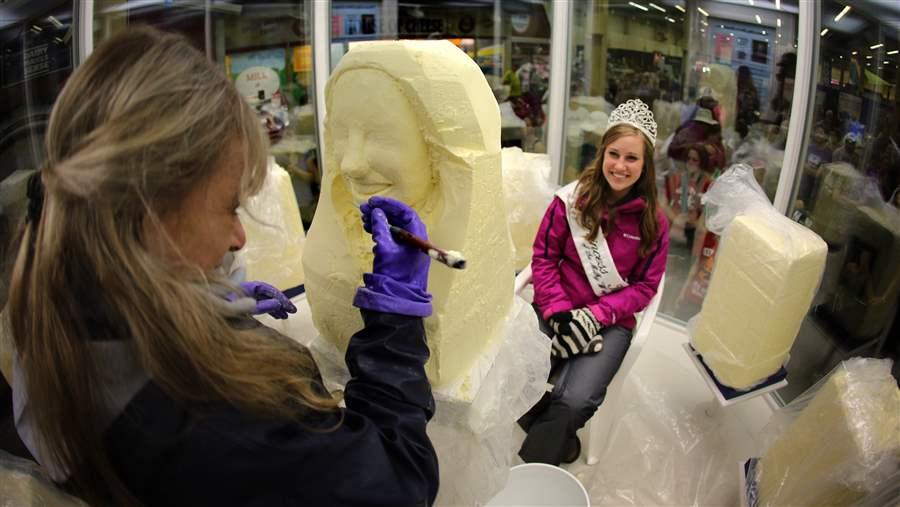State Fairs: Beyond Butter Sculptures to Drones and Yoga
 © The Associated Press/The Star Tribune, Brian Mark Peterson
© The Associated Press/The Star Tribune, Brian Mark Peterson
A sculptor works in the butter cooler at the Minnesota State Fair. To remain relevant, many states are adding drones, virtual reality attractions and craft beers to traditional agricultural offerings.
The Butter Cow, a life-size statue carved of pure cream Iowa butter, has drawn fans to the Iowa State Fair for more than a century. The 600-pound bovine packs enough butter for more than 19,000 slices of toast, and would take the average person two lifetimes to eat.
But 21st century fair goers expect something more: In addition to the cow and other traditional agricultural attractions, this year’s fair featured yoga and Zumba, craft beers and gluten-free corndogs.
To remain relevant, state fairs across the country — the latest ones will conclude this month — are going modern.
The California State Fair, for example, hosted the first U.S. National Drone Racing Championships, with 120 pilots competing for $25,000 in prizes. The drone races thrilled spectators, but they also showcased technology that can be used to monitor moisture and temperature in vineyards, track cattle and dust crops.
This year’s California fair also featured Tech Trek, an exhibit exploring how science fiction becomes science fact, with 3-D printing and robots. Also for the first time: an official fair chef. Keith Breedlove, a tattooed urban hipster and food truck entrepreneur, demonstrated cooking techniques.
In Washington, D.C., where cultivation of marijuana is now legal, the D.C. State Fair sponsored its first “Best Bud” competition, while the Indiana State Fair encouraged fairgoers to take and post a #farmerselfie with a different farm family every day of the fair. The New Mexico State Fair capitalized on the craft beer craze with an official New Mexico State Fair Beer. Organizers promoted the “tasty, cream ale” as “perfect for washing down fried foods from one of the many food vendors!”
“Two types of people come to our fair,” said Gary Slater, Iowa State Fair CEO. “Half don’t want us to change a thing, year after year. The other 50 percent say, ‘Been there, done that. Wow me somehow this year — or I won’t be back.’”
European Roots
Fairs seem quintessentially American, but settlers brought them from Europe and England. The York, Pennsylvania, fair celebrated its 250th anniversary this year. New York claims the first state fair, in 1841. About 150 million people go to fairs in the United States annually, said Jim Tucker, president of the International Association of Fairs and Expositions.
In some states, the fair attracts more people than any other event. That’s the case in Iowa, where more than 1 million people visit the state fair. The State Fair of Texas, which runs until Sunday, is the nation’s largest with nearly 2.9 million visitors last year. Other livestock shows and expos also draw huge crowds.
But they have changed.
“At one time, they were state fairs and states would pick up the tab,” said Doug Farquhar at the National Conference of State Legislatures. “States more and more lost patience with that payment model,” he said.
Most state fairs now are nonprofits that receive little or no state funds. They rely for their operating budgets on ticket sales, along with corporate sponsorships and revenue from vendors, carnival games and rides. Others receive state funds for capital improvements or for 4-H premiums, cash prizes awarded to young exhibitors in various competitions. A few, such as the Georgia State Fair, are run by for-profit companies.
The Minnesota State Fair, a 12-day, $50 million enterprise, is the nation’s second largest state fair and set an attendance record of more than 1.8 million ticketed visitors in 2014. This year, attendance was slightly less than 1.8 million. A study estimated the fair’s annual economic impact for the Twin Cities is $200 million.
“We don’t get a dime in state money and don’t want it. There are always strings,” said Jerry Hammer, general manager of the Minnesota State Fair “When the fate of an institution depends on political whims, it’s not a good situation.”
The entire extent of state financial support of the Virginia State Fair is $25,000 for 4-H premiums.
“There’s no handout, nor should there be,” said Marlene Pierson-Jolliffe, who oversees the State Fair of Virginia after spending nearly 25 years with the State Fair of West Virginia.
“Fairs have had to decide to apply solid business principles, get creative and aggressive,” she said. “It’s a tough business.”
Showcasing Products
But even as fairs have updated their attractions, their main mission has remained the same: showcasing state products, especially agricultural products. “At state fairs, among other things you meet the people who are feeding you,” said Minnesota’s Hammer. “That’s a good thing.”
This month’s North Carolina State Fair will showcase some of the state’s 160 wineries and 525 commercial grape growers with a State Fair Wine Competition. Winners will be displayed in the Education Building and North Carolina wines will be sold during the fair.
At the Kentucky State Fair in August, amateur chefs entered their bourbon-laced entrees, soups, stews, barbecues and casseroles in the Evan Williams Kentucky Straight Bourbon Whiskey cooking contest. Top prize was $250 and the honor of being included in the company’s “Cooking with Bourbon” recipe booklet.
Six New England state fairs are held together at the Big E (for “Exposition”) in West Springfield, Massachusetts. Each state builds a replica of its original statehouse where it exhibits and promotes state products.
This year, Big E attendees munched on Maine baked potatoes, sampled Vermont cheddar and sipped New Hampshire apple cider.
With less than 2 percent of Americans involved in farming, state fairs want to educate attendees about where food comes from.
“Our greatest challenge is to be relevant,” said Pierson-Jolliffe of Virginia. “Our ag education piece sets us apart from just going to a carnival in a parking lot.”
No comments:
Post a Comment